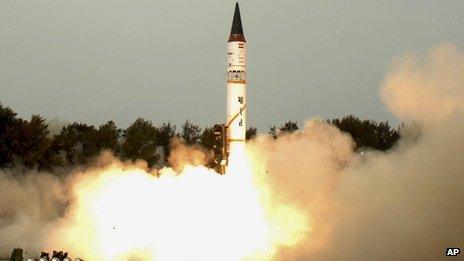Agni-V missile to take India into elite nuclear club
- Published

The Agni range of missiles have been fully developed in India
With the launch of its locally-developed Agni-V, India has joined a small group of countries - up to now only the nuclear-armed superpowers - with inter-continental range ballistic missiles
A successful test flight of the missile will also strengthen India's nuclear deterrence once it comes into service by 2014-15.
With a range of more than 5,000km (3,100 miles), the Agni-V is capable of delivering a single 1.5-ton warhead deep inside nuclear rival China's territory.
It is 17.5m-tall, solid-fuelled, has three stages and a launch weight of 50 tons. It has cost more than 2.5bn rupees ($480m; £307m) to develop.
India's retaliatory, no-first use strategic deterrence is based on nuclear weapons delivered by sea, air and mobile land-based systems.
These include Agni missile variants with strike ranges from 700km to - it is anticipated with the Agni-V - more than 5,000km.
The maiden test flight of the missile, developed by the Defence Research and Development Organisation (DRDO), has been delayed beyond its original December 2011 deadline.
"Fired from a canister-launch system to provide it greater operational flexibility of being either rail- or road-launched, the Agni-V compares favourably with ICBMs in use by nuclear weapons states like Britain, China, France, Russia and the US," DRDO chief VK Saraswat said.
Briefing reporters at the recently-concluded Defexpo 2012 in Delhi, Mr Saraswat said that advanced technologies incorporated into Agni-V were "far ahead of other countries with few exceptions, like the US".
'Innovative'
Missiles available to other nuclear weapons states employ relatively older technology, he said.
Agni-V's innovative technologies include composite rocket motors, guidance ring-laser gyro-based inertial navigation systems, micro-navigation systems and accelerometers to measure the ICBM's acceleration and detect any change in its vehicular motion.
Composites have been extensively used to reduce the ICBM's weight. A third, miniaturised stage has been added to the Agni-III to boost its range from 3,500km to more than 5,000km.

Agni-V missile will be capable of hitting targets in China
DRDO scientists said many of the components of the Agni-III and Agni-IV - which were successfully test-fired over the last two years - have been incorporated into the latest missile.
Avinash Chander, director of the DRDO-run Advanced Systems Laboratory, which is closely involved in developing the Agni missiles, says engineering the Agni-V's third stage proved to be a major technological challenge.
"It (the third stage) slopes into the warhead stage and has a conical motor. So far, we have only been doing cylindrical motors and building that was difficult," Mr Chander said in October last year.
DRDO officials say a reduced payload will further enhance the Agni-V's range to beyond 5,000km.
"Agni-V will provide India with much-needed dissuasive deterrence against China which at present it lacks," said former Brigadier Arun Sahgal, joint director of the Institute of National Security Studies in Delhi.
"With Agni-V trials, India's strategic lacunae will to a large extent be overcome," he added.
India, which came off worse in its 1962 border war with China over one of the world's longest-running disputes, had claimed that fear of Beijing's burgeoning nuclear arsenal was responsible for it conducting its five underground nuclear tests in May 1998.
Concern over China's intermediate- and long-range missile capability also hastened India's indigenous programme to develop its own strategic weapons.
Indian military planners remain apprehensive over China's nuclear-capable DF21 intermediate-range ballistic missile (IRBM) and its many variants which have ranges of 1,500km-2,250km.
These are deployed across Tibet and south-west China and are capable of striking major Indian cities, including Delhi.
India's arsenal of IRBMs, on the other hand, includes the Agni-I, Agni-II and Agni-III with ranges of between 700-800km, 2,000-2,300km and over 3,500km respectively.
The missiles are being built at Bharat Dynamics Limited in Hyderabad under the DRDO's supervision and operated by the Strategic Forces Command
Created in January 2003, the command is responsible for the management and administration of the country's nuclear weapons stockpile and is part of India's overarching Nuclear Command Authority.
The shorter-range Agni-I and II were developed with nuclear rival Pakistan in mind.
The Agni III, however, is directed at Chinese military and nuclear assets ranged in Tibet, a region of increasing strategic significance to both Delhi and Beijing.

- Published22 December 2010